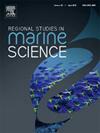Impact of cooking methods on the nutritional profile, microelements and Se-Pb risk-benefit of farmed shrimp (Penaeus vannamei)
IF 2.1
4区 环境科学与生态学
Q3 ECOLOGY
引用次数: 0
Abstract
This research investigated how different cooking techniques such as boiling (BS), frying (FS), grilling (GS), and microwaving (MS) affect the macronutrient profile (including protein, fat, fatty acids, amino acids, calcium, and magnesium), trace elements (such as Cu, Zn, Fe, and Se), and the toxic element (Pb) in shrimp (Penaeus vannamei). The findings indicated a significant increase in protein and fat in cooked shrimp (p < 0.05) due to moisture loss. However, macronutrients such as Ca and Mg were notably reduced during cooking, except for boiled shrimp. Boiling and grilling significantly reduced both essential and non-essential amino acids, such as histidine, serine, and tyrosine, whereas microwaving and frying decreased lysine and methionine levels in cooked shrimp. Regarding fatty acids (FAs), boiling, frying, and microwaving did not notably affect arachidonic acid, EPA, and DHA, although grilling caused slight alterations in their content. Lipid health indices (AI, TI, HI, HPI, NVI, and FLQI) indicate that both raw and cooked shrimp offer health-beneficial FAs and may help reduce cardiovascular diseases. Meanwhile, oxidation indices (OSA and COX) showed that the extracted shrimp fat exhibited good oxidative stability and resistance to auto-oxidation. The study also evaluated the Se:Pb molar ratio, Se-health benefit indices (Se-HBI) (Se-HBV and HBVSe), and benefit-risk value (BRV) owing to the growing link between the protective role of Se and Pb toxicity. The Se:Pb ratio and Se-HBI were > 1, highlighting the protective effect of Se against Pb exposure, whereas positive BRV values suggest that shrimp consumption provides health benefits rather than risks. The relatively higher retention of microelements observed during boiling and microwaving suggests that these methods are more suitable for cooking shrimps. This study demonstrated that Se mitigates Pb exposure by forming a Se-Pb complex, which will be considered in future risk assessments and formulation of seafood safety guidelines.
烹饪方式对凡纳滨对虾营养成分、微量元素及硒-铅风险-收益的影响
本研究考察了煮沸(BS)、油炸(FS)、烧烤(GS)和微波(MS)等不同烹饪技术对凡纳美对虾(Penaeus vannamei)体内常量营养素(包括蛋白质、脂肪、脂肪酸、氨基酸、钙和镁)、微量元素(如Cu、Zn、Fe和Se)和有毒元素(Pb)的影响。结果表明,由于水分的流失,熟虾的蛋白质和脂肪含量显著增加(p <; 0.05)。然而,除了煮虾外,烹饪过程中钙和镁等常量营养素明显减少。煮沸和烧烤会显著减少必需和非必需氨基酸,如组氨酸、丝氨酸和酪氨酸,而微波和油炸会降低熟虾中的赖氨酸和蛋氨酸水平。至于脂肪酸(FAs),煮沸、油炸和微波对花生四烯酸、EPA和DHA的影响不明显,尽管烧烤对它们的含量有轻微的影响。脂质健康指数(AI、TI、HI、HPI、NVI和FLQI)表明,生虾和熟虾都提供有益健康的脂肪酸,并可能有助于减少心血管疾病。同时,氧化指标(OSA和COX)表明,提取的虾脂具有良好的氧化稳定性和抗自氧化能力。研究还评估了硒:铅的摩尔比、硒健康益处指数(Se- hbi) (Se- hbv和HBVSe)和益处-风险值(BRV),因为硒和铅毒性之间的保护作用日益密切。硒:铅比和硒- hbi为>; 1,突出了硒对铅暴露的保护作用,而阳性的BRV值表明食用虾对健康有益而不是有风险。在蒸煮和微波过程中观察到的相对较高的微量元素保留率表明这些方法更适合烹饪虾。该研究表明,硒通过形成硒-铅复合物来减轻铅暴露,这将在未来的风险评估和海产品安全指南的制定中得到考虑。
本文章由计算机程序翻译,如有差异,请以英文原文为准。
求助全文
约1分钟内获得全文
求助全文
来源期刊

Regional Studies in Marine Science
Agricultural and Biological Sciences-Ecology, Evolution, Behavior and Systematics
CiteScore
3.90
自引率
4.80%
发文量
336
审稿时长
69 days
期刊介绍:
REGIONAL STUDIES IN MARINE SCIENCE will publish scientifically sound papers on regional aspects of maritime and marine resources in estuaries, coastal zones, continental shelf, the seas and oceans.
 求助内容:
求助内容: 应助结果提醒方式:
应助结果提醒方式:


